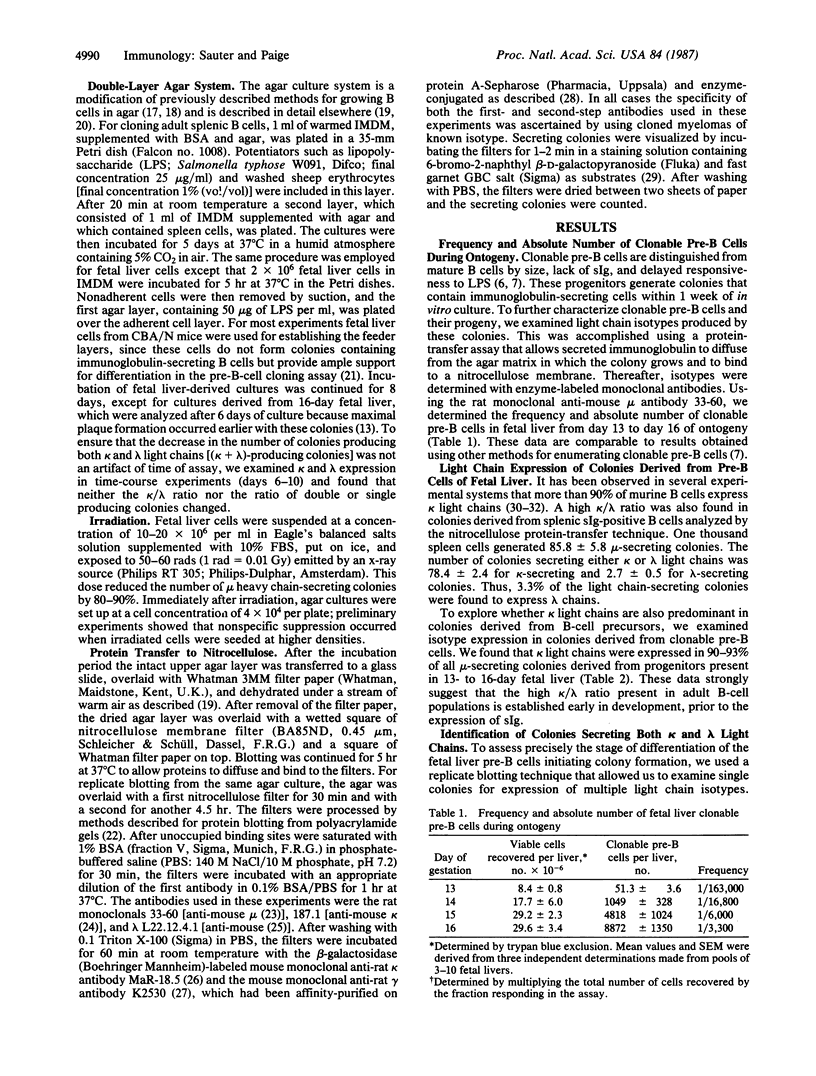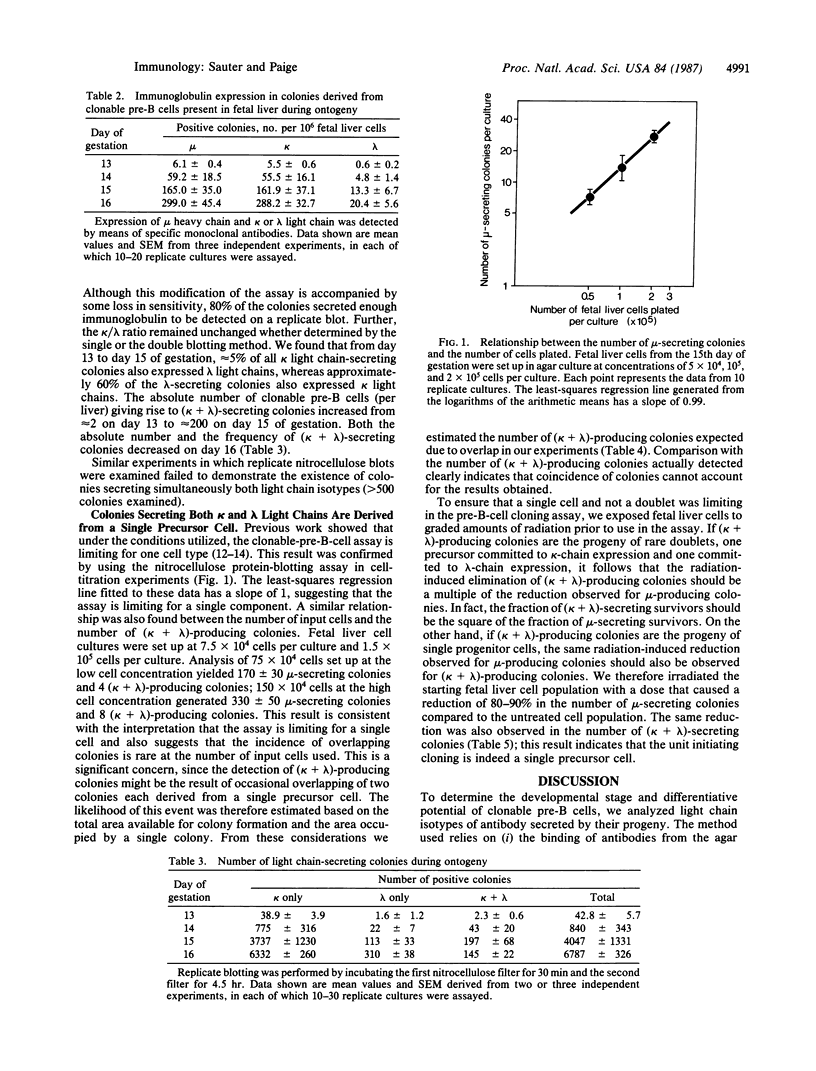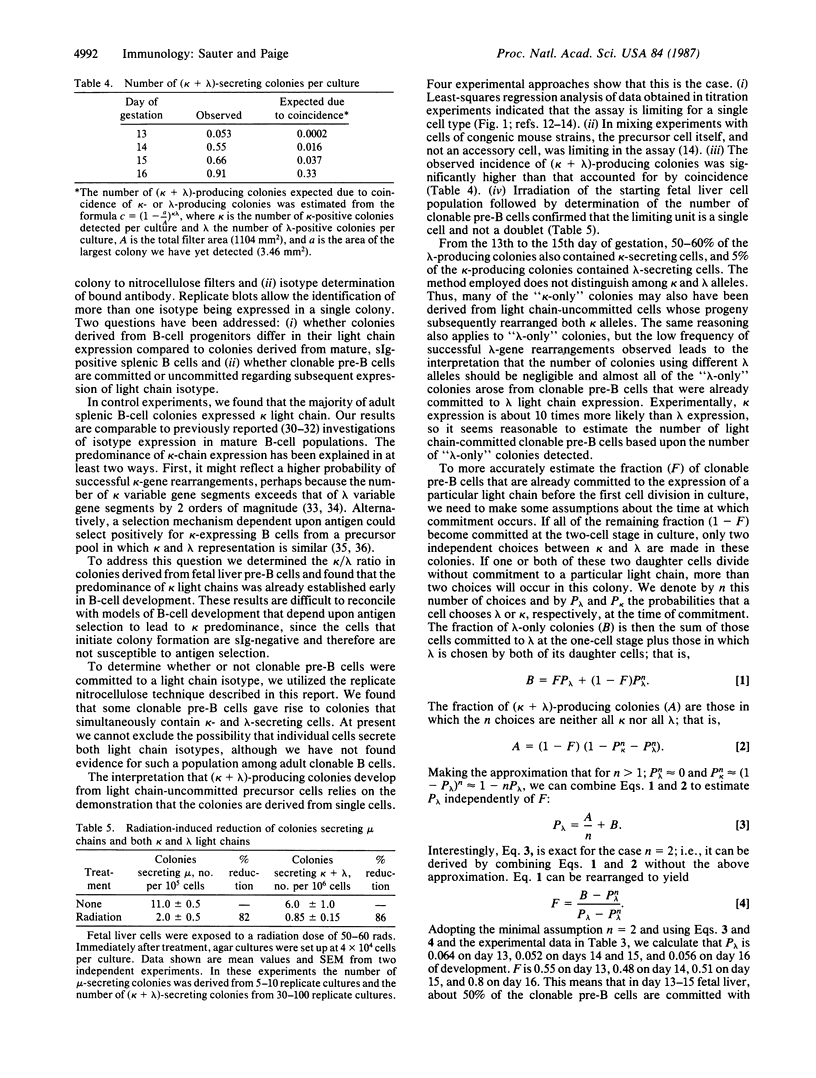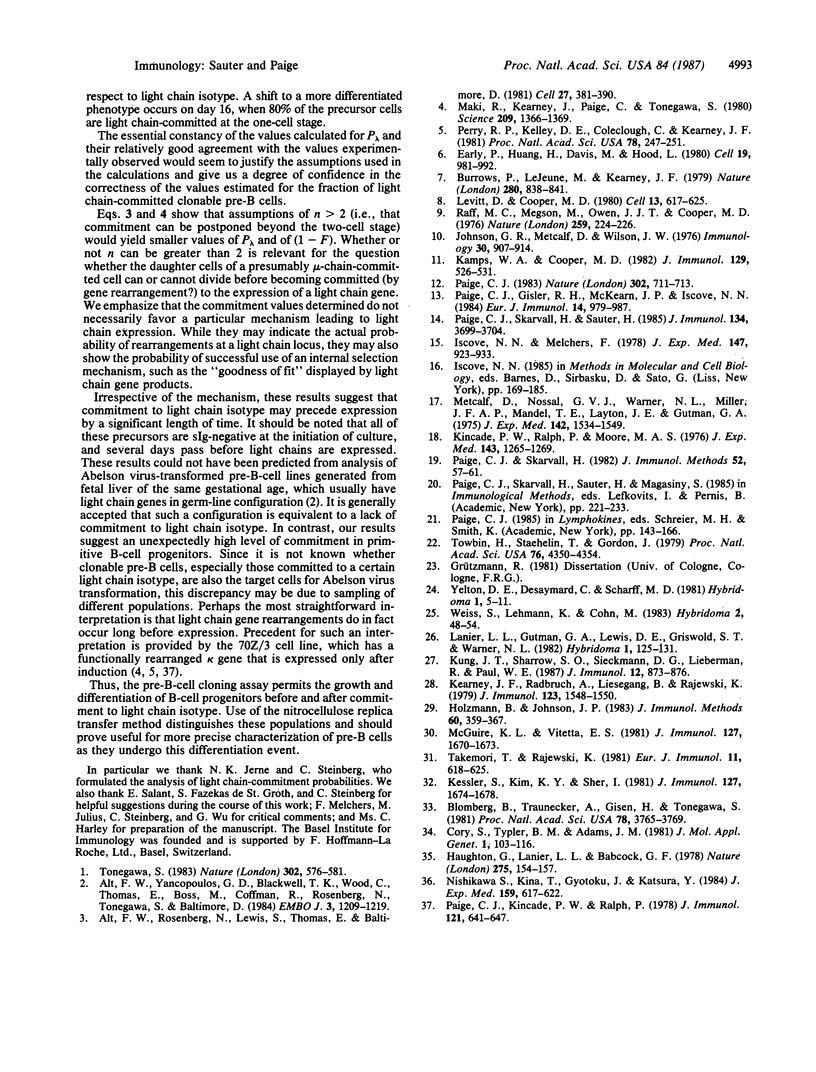Abstract
The pre-B-cell cloning assay is an in vitro differentiation system in which B-lymphocyte precursors expand and generate colonies containing immunoglobulin-secreting cells. Analysis of surface characteristics, growth requirements, and kinetics suggested that these cells represent early stages of the B-cell differentiation pathway. Here we describe a modification of the assay, which allowed us to determine the differentiative potential of these clonable pre-B cells. Using a nitrocellulose protein-transfer technique, we studied immunoglobulin light chain expression in colonies derived from fetal mouse liver B-cell precursors; in particular, we explored whether the B-cell precursors are already committed to the expression of a particular light chain gene at the initiation of culture. Our results show that fetal liver-derived B-cell progenitors generate colonies in vitro that secrete kappa and lambda light chains at a ratio similar to that found in colonies derived from adult splenic B cells. Further, we document the existence of colonies that are derived from single cells and that simultaneously secrete both types of light chains. This indicates that the progenitors of (kappa + lambda)-producing colonies are light chain-uncommitted at the initiation of culture. These cells are able to rearrange their light chain genes in vitro and differentiate along the B-cell pathway to form colonies secreting both kappa and lambda chains.
Full text
PDF




Selected References
These references are in PubMed. This may not be the complete list of references from this article.
- Alt F. W., Yancopoulos G. D., Blackwell T. K., Wood C., Thomas E., Boss M., Coffman R., Rosenberg N., Tonegawa S., Baltimore D. Ordered rearrangement of immunoglobulin heavy chain variable region segments. EMBO J. 1984 Jun;3(6):1209–1219. doi: 10.1002/j.1460-2075.1984.tb01955.x. [DOI] [PMC free article] [PubMed] [Google Scholar]
- Alt F., Rosenberg N., Lewis S., Thomas E., Baltimore D. Organization and reorganization of immunoglobulin genes in A-MULV-transformed cells: rearrangement of heavy but not light chain genes. Cell. 1981 Dec;27(2 Pt 1):381–390. doi: 10.1016/0092-8674(81)90421-9. [DOI] [PubMed] [Google Scholar]
- Blomberg B., Traunecker A., Eisen H., Tonegawa S. Organization of four mouse lambda light chain immunoglobulin genes. Proc Natl Acad Sci U S A. 1981 Jun;78(6):3765–3769. doi: 10.1073/pnas.78.6.3765. [DOI] [PMC free article] [PubMed] [Google Scholar]
- Burrows P., LeJeune M., Kearney J. F. Evidence that murine pre-B cells synthesise mu heavy chains but no light chains. Nature. 1979 Aug 30;280(5725):838–840. doi: 10.1038/280838a0. [DOI] [PubMed] [Google Scholar]
- Cory S., Tyler B. M., Adams J. M. Sets of immunoglobulin V kappa genes homologous to ten cloned V kappa sequences: implications for the number of germline V kappa genes. J Mol Appl Genet. 1981;1(2):103–116. [PubMed] [Google Scholar]
- Early P., Huang H., Davis M., Calame K., Hood L. An immunoglobulin heavy chain variable region gene is generated from three segments of DNA: VH, D and JH. Cell. 1980 Apr;19(4):981–992. doi: 10.1016/0092-8674(80)90089-6. [DOI] [PubMed] [Google Scholar]
- Haughton G., Lanier L. L., Babcock G. F. The murine kappa light chain shift. Nature. 1978 Sep 14;275(5676):154–157. doi: 10.1038/275154a0. [DOI] [PubMed] [Google Scholar]
- Holzmann B., Johnson J. P. A beta-galactosidase linked immunoassay for the analysis of antigens on individual cells. J Immunol Methods. 1983 Jun 10;60(3):359–367. doi: 10.1016/0022-1759(83)90293-4. [DOI] [PubMed] [Google Scholar]
- Iscove N. N., Melchers F. Complete replacement of serum by albumin, transferrin, and soybean lipid in cultures of lipopolysaccharide-reactive B lymphocytes. J Exp Med. 1978 Mar 1;147(3):923–933. doi: 10.1084/jem.147.3.923. [DOI] [PMC free article] [PubMed] [Google Scholar]
- Johnson G. R., Metcalf D., Wilson J. W. Development of B-lymphocyte colony-forming cells in foetal mouse tissues. Immunology. 1976 Jun;30(6):907–914. [PMC free article] [PubMed] [Google Scholar]
- Kamps W. A., Cooper M. D. Microenvironmental studies of pre-B and B cell development in human and mouse fetuses. J Immunol. 1982 Aug;129(2):526–531. [PubMed] [Google Scholar]
- Kearney J. F., Radbruch A., Liesegang B., Rajewsky K. A new mouse myeloma cell line that has lost immunoglobulin expression but permits the construction of antibody-secreting hybrid cell lines. J Immunol. 1979 Oct;123(4):1548–1550. [PubMed] [Google Scholar]
- Kessler S., Kim K. J., Scher I. Surface membrane kappa and lambda light chain expression on spleen cells of neonatal and maturing normal and immune-defective CBA/NB mice: the kappa:lambda ratio is constant. J Immunol. 1981 Oct;127(4):1674–1678. [PubMed] [Google Scholar]
- Kincade P. W., Ralph P., Moore M. A. Growth of B-lymphocytes clones in semisolid culture is mitogen dependent. J Exp Med. 1976 May 1;143(5):1265–1270. doi: 10.1084/jem.143.5.1265. [DOI] [PMC free article] [PubMed] [Google Scholar]
- Lanier L. L., Gutman G. A., Lewis D. E., Griswold S. T., Warner N. L. Monoclonal antibodies against rat immunoglobulin kappa chains. Hybridoma. 1982;1(2):125–131. doi: 10.1089/hyb.1.1982.1.125. [DOI] [PubMed] [Google Scholar]
- Levitt D., Cooper M. D. Mouse pre-B cells synthesize and secrete mu heavy chains but not light chains. Cell. 1980 Mar;19(3):617–625. doi: 10.1016/s0092-8674(80)80038-9. [DOI] [PubMed] [Google Scholar]
- Maki R., Kearney J., Paige C., Tonegawa S. Immunoglobulin gene rearrangement in immature B cells. Science. 1980 Sep 19;209(4463):1366–1369. doi: 10.1126/science.6774416. [DOI] [PubMed] [Google Scholar]
- McGuire K. L., Vitetta E. S. kappa/lambda Shifts do not occur during maturation of murine B cells. J Immunol. 1981 Oct;127(4):1670–1673. [PubMed] [Google Scholar]
- Metcalf D., Nossal G. J., Warner N. L., Miller J. F., Mandel T. E., Layton J. E., Gutman G. A. Growth of B-lymphocyte colonies in vitro. J Exp Med. 1975 Dec 1;142(6):1534–1549. doi: 10.1084/jem.142.6.1534. [DOI] [PMC free article] [PubMed] [Google Scholar]
- Nishikawa S. I., Kina T., Gyotoku J. I., Katsura Y. High frequency of lambda gene activation in bone marrow pre-B cells. J Exp Med. 1984 Feb 1;159(2):617–622. doi: 10.1084/jem.159.2.617. [DOI] [PMC free article] [PubMed] [Google Scholar]
- Paige C. J., Gisler R. H., McKearn J. P., Iscove N. N. Differentiation of murine B cell precursors in agar culture. Frequency, surface marker analysis and requirements for growth of clonable pre-B cells. Eur J Immunol. 1984 Nov;14(11):979–987. doi: 10.1002/eji.1830141104. [DOI] [PubMed] [Google Scholar]
- Paige C. J., Kincade P. W., Ralph P. Murine B cell leukemia line with inducible surface immunoglobulin expression. J Immunol. 1978 Aug;121(2):641–647. [PubMed] [Google Scholar]
- Paige C. J., Skarvall H. Plaque formation by B cell colonies. J Immunol Methods. 1982;52(1):51–61. doi: 10.1016/0022-1759(82)90349-0. [DOI] [PubMed] [Google Scholar]
- Paige C. J., Skarvall H., Sauter H. Differentiation of murine B cell precursors in agar culture. II. Response of precursor-enriched populations to growth stimuli and demonstration that the clonable pre-B cell assay is limiting for the B cell precursor. J Immunol. 1985 Jun;134(6):3699–3704. [PubMed] [Google Scholar]
- Paige C. J. Surface immunoglobulin-negative B-cell precursors detected by formation of antibody-secreting colonies in agar. Nature. 1983 Apr 21;302(5910):711–713. doi: 10.1038/302711a0. [DOI] [PubMed] [Google Scholar]
- Perry R. P., Kelley D. E., Coleclough C., Kearney J. F. Organization and expression of immunoglobulin genes in fetal liver hybridomas. Proc Natl Acad Sci U S A. 1981 Jan;78(1):247–251. doi: 10.1073/pnas.78.1.247. [DOI] [PMC free article] [PubMed] [Google Scholar]
- Raff M. C., Megson M., Owen J. J., Cooper M. D. Early production of intracellular IgM by B-lymphocyte precursors in mouse. Nature. 1976 Jan 22;259(5540):224–226. doi: 10.1038/259224a0. [DOI] [PubMed] [Google Scholar]
- Takemori T., Rajewsky K. Lambda chain expression at different stages of ontogeny in C57BL/6, BALB/c and SJL mice. Eur J Immunol. 1981 Aug;11(8):618–625. doi: 10.1002/eji.1830110806. [DOI] [PubMed] [Google Scholar]
- Tonegawa S. Somatic generation of antibody diversity. Nature. 1983 Apr 14;302(5909):575–581. doi: 10.1038/302575a0. [DOI] [PubMed] [Google Scholar]
- Towbin H., Staehelin T., Gordon J. Electrophoretic transfer of proteins from polyacrylamide gels to nitrocellulose sheets: procedure and some applications. Proc Natl Acad Sci U S A. 1979 Sep;76(9):4350–4354. doi: 10.1073/pnas.76.9.4350. [DOI] [PMC free article] [PubMed] [Google Scholar]
- Weiss S., Lehmann K., Cohn M. Monoclonal antibodies to murine immunoglobulin isotypes. Hybridoma. 1983;2(1):49–54. doi: 10.1089/hyb.1983.2.49. [DOI] [PubMed] [Google Scholar]
- Yelton D. E., Desaymard C., Scharff M. D. Use of monoclonal anti-mouse immunoglobulin to detect mouse antibodies. Hybridoma. 1981;1(1):5–11. doi: 10.1089/hyb.1.1981.1.5. [DOI] [PubMed] [Google Scholar]


